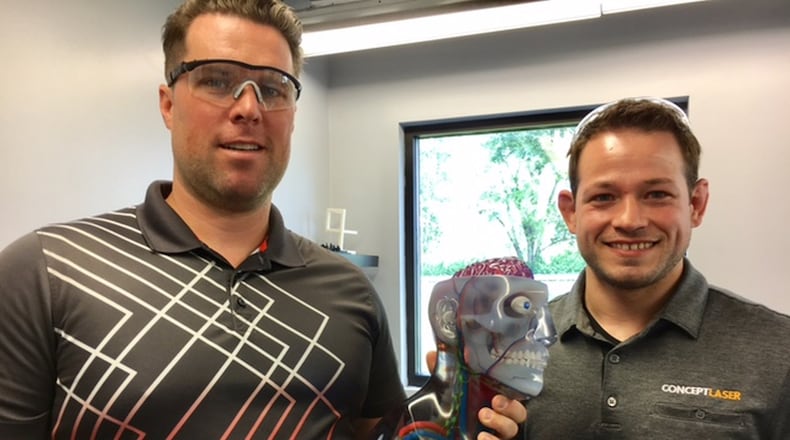The 3-D printing manufacturer has moved into 25,000 square feet of industrial-warehouse space in the former home of Miami Valley Publishing, 678 Yellow Springs-Fairfield Road.
Sales grew by 400 percent in 2016 and are on track for similar growth this year, company officials say, leading the privately held business to seek elbow room.
The business has invested more than $3 million in new equipment in the past year or so, fueled by bank loans and traditional financing — as well as investments from the Sheffer Corp. in Cincinnati.
“We’re about to add our 11th employee, hopefully by the end of the month,” said Adam Clark, Tangible Solution’s chief executive.
With Chief Operating Officer Chris Collins at his side, Clark’s aims are not humble. “Our mission is to change the way we make everything in our life,” the company says on its Facebook page. “We will lead the revolution on how the world manufactures everything.”
“We’re pretty much focused on the industrialization of additive manufacturing,” Clark said in an interview at his company’s new home last week.
Rob Anderson, Fairborn city manager, said that when he first met met Clark and Collins, he could tell they were “going to do something pretty amazing.”
After performing due diligence, city leaders and Fairborn City Council agreed to give Tangible a $500,000 loan, which Anderson acknowledged is unusual for the city to do. Fairborn issued some short-term debt to make the financing happen. The city expects to get paid back with interest.
Additive manufacturing — often called “3-D printing” — has turned heads in recent years. Last year, General Electric announced it would spend $1.4 billion to acquire two 3-D printing firms, Arcam AB, based in Sweden, and SLM Solutions Group AG, a German firm.
Last year, a report by the Consumer Technology Association and UPS said that the additive manufacturing industry will grow to $21 billion by 2020. The primary market — including 3D printers, materials, supplies and service — has grown at least 30 percent each year from 2012 to 2014, the report said.
Clark and Collins see themselves as being on the front lines of a new industrial revolution, refining new, quicker, less expensive ways to make nearly everything with less material.
“What you see out here on the floor, we truly believe we’re accelerating the use of additive manufacturing — not prototyping but more production,” Clark said.
Their main goal is to become a Tier 1 supplier to end users and original equipment manufacturers, but today their focus is medical device implants — manufactured products made to strengthen the human body from the inside.
Collins points to structures used to mimic the internal structures of bones — 3-D printed trabecular structures that are randomly porous, but he says Tangible can control how dense the medical implant material is.
Such a material can actually stimulate cell growth, Collins said.
“This is not something that can be traditionally made at all,” he said. “This entire structure is a lattice, all the way. It’s not just a surface structure.”
“We’re a brand new type of contract manufacturer,” Clark said.
Tangible is not testing new types of processes or materials, but compared to traditional computer numeric control metal cutting and shaping, what they do is relatively new.
The process involves laying layers of powder precisely over earlier layers to gradually build up and shape a three-dimensional end product.
“We’re fusing the entire part together, as we build one layer at a time,” Collins said.
While the two men are pleased with their new work space, if their present pace of growth is maintained, they say they may need more space in five years — or sooner.
“We’d like to think we’re one of the first mature (additive manufacturing) contract manufacturers supplying great parts,” Clark said.
About the Author

